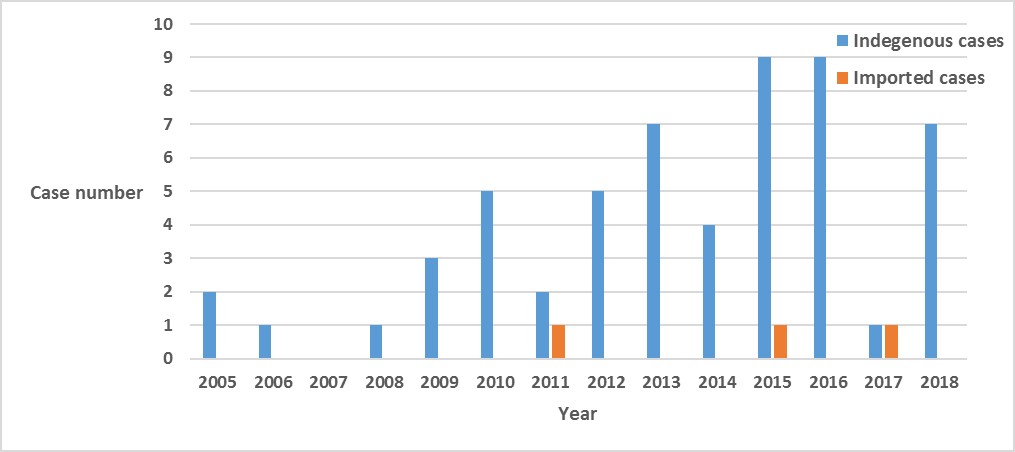- About CDC
- Diseases & Conditions
- Programs & Campaigns
-
Data & Statistics
- Taiwan National Infectious Disease Statistics System
- Statistics of HIV/AIDS
- Disease Surveillance Express
- Influenza Express
- National Notifiable Disease Surveillance Report
- Weekly Report of Enterovirus Infection
- Taiwan Healthcare-associated infection and Antimicrobial resistance Surveillance System
- Taiwan CDC Open Data Portal
- International Cooperation
-
About CDC
- Diseases & Conditions
-
Programs & Campaigns
-
Data & Statistics
- Taiwan National Infectious Disease Statistics System
- Statistics of HIV/AIDS
- Disease Surveillance Express
- Influenza Express
-
National Notifiable Disease Surveillance Report
National Notifiable Disease Surveillance Report
-
Weekly Report of Enterovirus Infection
Weekly Report of Enterovirus Infection
- Weekly Report 2025
- Weekly Report 2024
- Weekly Report 2023
- Weekly Report 2022
- Weekly Report 2021
- Weekly Report 2020
- Weekly Report 2019
- Weekly Report 2018
- Weekly Report 2017
- Weekly Report 2016
- Weekly Report 2015
- Weekly Report 2014
- Weekly Report 2013
- Weekly Report 2012
- Weekly Report 2011
- Weekly Report 2010
- Weekly Report 2009
- Weekly Report 2008
- Taiwan Healthcare-associated infection and Antimicrobial resistance Surveillance System
- Taiwan CDC Open Data Portal
- International Cooperation
- News
- Privacy Policy
- Security Policy
- Government Website Open Information Announcement
- Copyright Notice on Health Educational Materials
Background
Cholera is an acute, diarrheal illness caused by infection of the intestine with the bacterium Vibrio cholerae serogroup O1 and/or O139. People usually catch cholera from contaminated water or food. The infection is often mild or without symptoms, but can sometimes be severe. Approximately one in 10% infected persons will have severe disease characterized by profuse watery diarrhea and vomiting. In these people, rapid loss of body fluids leads to dehydration and shock. Without treatment, death can occur within hours.
Epidemiology
During the 19th century, cholera spread across the world from its original reservoir in the Ganges delta in India. Six subsequent pandemics killed millions of people across all continents. The current (seventh) pandemic started in South Asia in 1961, and reached Africa in 1971 and the Americas in 1991. Cholera is now endemic in many countries. Every year, there are an estimated 2.9 million cholera cases and 95,000 deaths around the world due to cholera.
Two serogroups of V. cholerae – O1 and O139 – cause outbreaks. V. cholerae O1 causes the majority of outbreaks, while O139 – first identified in Bangladesh in 1992 – is confined to South-East Asia. Non-O1 and non-O139 V. cholerae can cause mild diarrhoea but do not generate epidemics.
No cholera epidemics have occurred in Taiwan since a severe outbreak caused by V. Cholerae serogroup O1 occurred in 1962. Although, during the period 1962-2013, several cholera infections have occurred, only a few are cluster infections and most of the reported cases are sporadic. The infection sources for most of the indigenous cholera infections occurred during the late twentieth century had been epidemiologically associated with the consumption of soft shelled turtle raised from contaminated farm ponds. The infection sources of indigenous cholera cases occurred during the recent five years were all unable to be identified.

Figure: Cholera Confirmed Cases in Taiwan, 2002-2018
Cholera Surveillance in Taiwan
Taiwan National Infectious Disease Statistics System
Cholera
Prevention and Control
- Drink and use safe water.
- (1)Bottled water with unbroken seals and canned/bottled carbonated beverages are safe to drink and use.
- (2)Use safe water to brush your teeth, wash and prepare food, and to make ice.
- (3)Clean food preparation areas and kitchenware with soap and safe water and let dry completely before reuse.
- Wash your hands often with soap and safe water.
- (1)Before you eat or prepare food.
- (2)Before feeding your children.
- (3)After using the latrine or toilet.
- (4)After cleaning your child’s bottom.
- (5)After taking care of someone ill with diarrhea
- Use latrines or bury your feces; do not defecate in any body of water. Wash hands with soap and safe water after defecating.
- Cook food well (especially seafood), keep it covered, eat it hot, and peel fruits and vegetables.
- (1)Be sure to cook shellfish (like crabs and crayfish) until they are very hot all the way through.
- (2)Avoid raw foods other than fruits and vegetables you have peeled yourself.
FAQs
- What is cholera?
- Cholera is an acute intestinal infection caused by ingestion of food or water contaminated with the bacterium Vibrio cholerae. It has a short incubation period, from less than one day to five days, and produces an enterotoxin that causes copious, painless, watery diarrhoea that can quickly lead to severe dehydration and death if treatment is not promptly given. Vomiting also occurs in most patients.
- How is Cholera Spread?
- (1)Cholera germs are found in the feces of infected people.
- (2)Cholera is spread when feces from an infected person gets into the water people drink or the food people eat.
- (3)Cholera is not likely to spread directly from one person to another.
- How can you avoid cholera?
- (1)Eat cooked food, avoid raw and cold dishes.
- (2)Avoid undercooked or raw fish or shellfish.
- (3)Avoid eating ready-peeled fruits.
- (4)Avoid foods and beverages from street vendors.
- (5)Handwashing before eating and after toilet visits.
More Information
Images

Attached Files
About CDC
Data & Statistics
- Taiwan National Infectious Disease Statistics System
- Statistics of HIV/AIDS
- Disease Surveillance Express
- Influenza Express
- National Notifiable Disease Surveillance Report
- Weekly Report of Enterovirus Infection
- Taiwan Healthcare-associated infection and Antimicrobial resistance Surveillance System
- Taiwan CDC Open Data Portal

